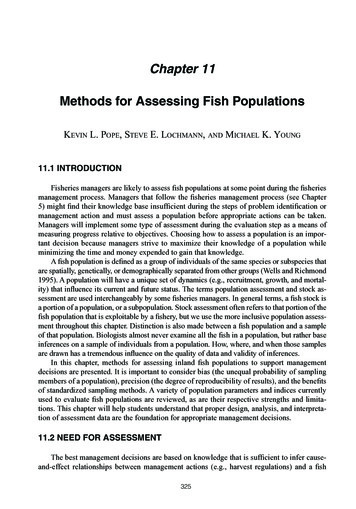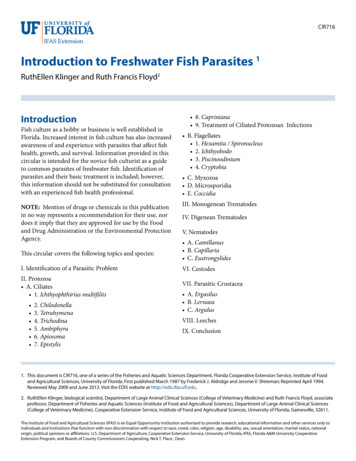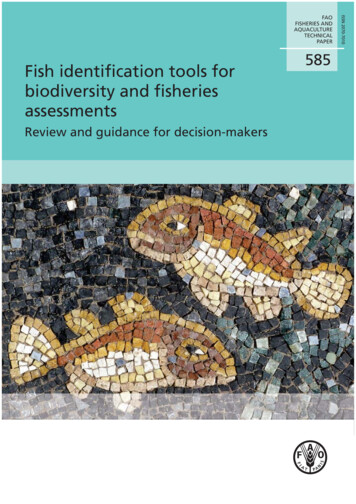
Transcription
Chapter 11Methods for Assessing Fish PopulationsKevin L. Pope, Steve E. Lochmann, and Michael K. Young11.1 INTRODUCTIONFisheries managers are likely to assess fish populations at some point during the fisheriesmanagement process. Managers that follow the fisheries management process (see Chapter5) might find their knowledge base insufficient during the steps of problem identification ormanagement action and must assess a population before appropriate actions can be taken.Managers will implement some type of assessment during the evaluation step as a means ofmeasuring progress relative to objectives. Choosing how to assess a population is an important decision because managers strive to maximize their knowledge of a population whileminimizing the time and money expended to gain that knowledge.A fish population is defined as a group of individuals of the same species or subspecies thatare spatially, genetically, or demographically separated from other groups (Wells and Richmond1995). A population will have a unique set of dynamics (e.g., recruitment, growth, and mortality) that influence its current and future status. The terms population assessment and stock assessment are used interchangeably by some fisheries managers. In general terms, a fish stock isa portion of a population, or a subpopulation. Stock assessment often refers to that portion of thefish population that is exploitable by a fishery, but we use the more inclusive population assessment throughout this chapter. Distinction is also made between a fish population and a sampleof that population. Biologists almost never examine all the fish in a population, but rather baseinferences on a sample of individuals from a population. How, where, and when those samplesare drawn has a tremendous influence on the quality of data and validity of inferences.In this chapter, methods for assessing inland fish populations to support managementdecisions are presented. It is important to consider bias (the unequal probability of samplingmembers of a population), precision (the degree of reproducibility of results), and the benefitsof standardized sampling methods. A variety of population parameters and indices currentlyused to evaluate fish populations are reviewed, as are their respective strengths and limitations. This chapter will help students understand that proper design, analysis, and interpretation of assessment data are the foundation for appropriate management decisions.11.2 NEED FOR ASSESSMENTThe best management decisions are based on knowledge that is sufficient to infer causeand-effect relationships between management actions (e.g., harvest regulations) and a fish325
326Chapter 11population (Radomski and Goeman 1996). Complete knowledge is rare or impossible to obtain, so managers attempt to acquire as much information about a fish population as resourcesallow. Frequent assessments may be necessary because population size, structure, and distribution fluctuate in response to environmental variation (Lett and Doubleday 1976; McRaeand Diana 2005). Natural disturbances, such as floods, droughts, or fires, and anthropogenicchanges, such as new fishing technologies, regulation changes, or nonnative fish introductions, can alter fish populations. Thus, status and trends in abundance, size or age structure,maturity schedules, or fecundity of fish in a population are central to informed decision making (Ault and Olson 1996; Post et al. 2003).Although fisheries managers still spend time attempting to understand the ecology andpopulation dynamics of sport fish species (Francis et al. 2007), the trend toward ecosystemmanagement (Cowx and Gerdeaux 2004) has caused managers to devote more attention tonongame species (Angermeier et al. 1991). Assessments of sport and nongame fish populations are similar but driven by different motivations. For instance, population assessments ofsport fish are often influenced by a desire to provide recreation or harvest for anglers, whereaspopulation assessments of nongame fish typically aim at maintaining or enhancing the distribution and abundance of these species. Fisheries professionals must integrate populationassessments of both types of fishes to implement ecosystem management properly.Finally, the tendency of the public to become increasingly involved in resource management decisions (Caddy 1999; Bettoli et al. 2007) has increased the need to understand fishpopulations. General information about fish populations is widely available (e.g., Froese andPauly 2008; NatureServe 2008) and sophisticated user groups can gain access to technicaldata, conduct analyses, and draw independent conclusions about particular fish populations(Beierle 2002). Managers can successfully interact with such groups by providing the resultsof population assessments with comprehensive analyses and interpretations based on soundscientific practices, including comparison with other findings published in peer-reviewedjournals.11.3 SAMPLING CONSIDERATIONS11.3.1 Bias and PrecisionChoosing how to sample and how to characterize a population are generally accorded themost emphasis in assessment programs. Determining sampling bias and precision are alsoimportant because bias or low precision make it difficult to identify the status of a population.For example, using electrofishing and the removal method to estimate the number of trout ina stream reach almost always results in an underestimate of fish abundance because the susceptibility of fish to capture by electrofishing declines as the number of capture attempts conducted over relatively short intervals (e.g., less than 1 h) increases (Riley and Fausch 1992).Moreover, the probability of capture of fish by electrofishing is also related to fish length,habitat complexity, stream size, water depth, water conductivity, species being sampled, andfish density. Adherence to consistent sampling protocols does not correct for bias, but if effortand catchability of fish remain constant among sampling events, the size and direction of thebias tend to remain constant and may permit meaningful population inferences. Still, testingfor this constancy is important (Box 11.1). Alternatively, a lack of precision can indicate that
Assessing Fish Populations327sampling efficiency is not constant or that too small a sample has been obtained. More intensive sampling may increase precision and reduce bias (White et al. 1982), but identifying andaccounting for the ecological, demographic, or habitat-related factors that affect samplingefficiency will produce the most reliable estimates of fish population parameters.Understanding bias and precision becomes particularly important when determiningwhether to estimate population parameters directly or to estimate population parameters indirectly by means of indices. An index is defined as a number or property that is presumablyrelated to a parameter of a fish population. Indices often require less effort or fewer resourcesthan do estimates of population parameters but still provide useful information. For example,obtaining a census of bluegill in a lake is difficult, but counts of fish obtained from nets setovernight are relatively easy to obtain and generally reflect fish abundance. Despite theirpopularity, indices should be used with caution. Often the form of the relationship betweenan index and the population parameter of interest may be poorly understood, temporally orspatially variable, or based on untested assumptions (Anderson 2003). Nevertheless, if theserelations can be well defined, indices can be a powerful tool for understanding populationstatus and trends (McKelvey and Pearson 2001; Hopkins and Kennedy 2004).11.3.2 Standardized SamplingIf the bias and precision of sampling gears, especially in variable environments, are unknown, standardized sampling may provide a means to assess trends (Bonar et al. 2009). Standardized sampling is defined as sampling with identical gear during the same season (or set ofenvironmental conditions) in the same manner over time or among fish populations. Doing sodoes not eliminate bias but theoretically holds the bias constant so that differences in indicescomputed from samples among years or fish populations can be attributed to relative changes in a population or relative differences among populations. Other benefits of standardizedsampling include improved communications among fisheries professionals and production oflarge-scale data sets beneficial for current and future assessments (Bonar and Hubert 2002).Failure to adopt standardized sampling approaches can prevent managers from detecting population trends or assessing population status. For example, electrofishing catch ratesof smallmouth bass are generally greater at night than during the day (Paragamian 1989). Ifelectrofishing samples are collected during the day in some years and at night in others and thedifference in vulnerability to capture is not addressed, a monitoring program may erroneouslyconclude that the smallmouth bass population is unstable.Standardized sampling protocols cannot substitute for an understanding of fish biology,population dynamics, and gear selectivity. For instance, fyke nets of a certain mesh size andoverall dimensions are regularly used in reservoirs to sample age-0 black crappie during thefall as an index of recruitment, but smaller fish are less likely to be captured than are largerfish (McInerny and Cross 2006). In years with early spawning by adult black crappie, manylarge age-0 fish may be captured during fall sampling and give the appearance that spawning and early survival were ample. In contrast, delayed spawning might result in fewer fallcaptures because age-0 black crappie would be smaller, giving the appearance that spawningand early survival were inadequate. A rigorous education in fisheries science that includessampling theory and fish ecology is a prerequisite for implementing standard fish samplingprotocols and analyzing the associated data.
328Chapter 11Box 11.1. Removal Model Abundance Estimates: Wrong but Useful?Amanda E. Rosenberger1All models are wrong, but some models are useful—a truism to live by for fisheriesmanagers. Consider the removal model, which uses standard depletion methods to generate an estimate of fish abundance. A primary assumption of the model is that samplingefficiency, or the proportion of fish removed from a site per capture event, is the same forall depletion capture events. However, fish that remain after the first depletion event areoften more difficult to capture during subsequent events because they seek cover that isdifficult to sample or continue to evade netters due to their relatively small size. Whensampling efficiency declines from depletion event to depletion event, the removal modelyields biased results: an underestimation of population size and an overestimation ofsampling efficiency (e.g., Riley and Fausch 1992; Peterson et al. 2004).This was the case for rainbow trout in small, headwater streams in the Boise Riverbasin in Idaho (Rosenberger and Dunham 2005). Rainbow trout were marked and leftin 31 sites (approximately 100 m in length) between two block nets to form “known”population sizes (following Peterson et al. 2004). After overnight recovery from initialcapture and marking, marked trout were sampled by means of standard backpack electrofishing depletion procedures. The removal model generated rainbow trout abundancesfrom depletion data that nearly always underestimated the number of marked fish actuallypresent, averaging only 75% of marked fish.The model yielded biased results. But could it still be useful? Managers faced withthis kind of bias may assert that, although the estimates are incorrect, removal estimatescan still be used as a relative index of fish abundance over space and through time. Methods need only be standardized and consistent, creating a highly precise, though wrong,answer. Further, estimates could be calibrated to known values with a simple correctionfactor to reflect actual fish numbers. This practice assumes that bias, though present, isconsistent and based primary on the methods used. It should not be influenced by variables that will change through space and time.A study in Idaho unfortunately refutes the assumption of constant sampling efficiency(Rosenberger and Dunham 2005). Not only were the removal estimates of rainbow troutabundance biased, but bias was inconsistent and influenced by stream habitat. Largerstreams and streams with more instream structure in the form of dead wood yielded morebiased estimates than did smaller streams with less instream cover. These stream featuresnegatively affected electrofishing sampling efficiency, implying that what decreases sampling efficiency can increase the bias of removal estimates (also see Peterson et al. 2004).Common differences among sites over space and through time, including size of habitat,presence of structure, size of fish, water temperature, and the density of fish, can affectthe sampling efficiency of electrofishing (e.g., Bayley and Dowling 1993; Dolan andMiranda 2003; Peterson et al. 2004). The Idaho study indicates that thorough validationof the removal model for generating absolute or comparable estimates of fish abundanceis needed before use. Therefore, a new motto is suggested: all models are wrong; validateand proceed cautiously.1University of Alaska–Fairbanks, School of Fisheries and Ocean Sciences, Fisheries Division.
Assessing Fish Populations32911.3.3 Probabilistic SamplingStatisticians frequently separate sampling designs according to whether probabilityor nonprobability sampling procedures are used (Levy and Lemeshow 1991). Probability sampling occurs when all possible samples are included in the selection process, theprobability of selection is known, and the selection process is random (or an approximation thereof). The most basic probability sampling procedure used in fish populationsampling is simple random sampling, in which a predetermined number of sampling sitesis selected from all possible sampling sites such that every potential site has an equalchance of being selected (Hansen et al. 2007). Estimates of population parameters fromprobability sampling can enable inferences about the entire population. Furthermore, precision (e.g., standard errors) of estimates can be determined from probability sampling(Wilde and Fisher 1996).Probability sampling may be impractical in many cases. Examples include smallscale assessments that occur in ponds or specialized habitats of rare organisms or situations in which information needed to design a probability sampling procedure is lacking.Nonprobability sampling may be used to provide information on trends in indices ofpopulation parameters (e.g., catch rate or size structure) of interest to managers (Wildeand Fisher 1996). Nonprobability sampling generally involves the nonrandom selectionof sample sites, frequently based on judgment or convenience, and limits the scope ofinference about fish populations. For example, samples collected from subjectively selected fixed sites, a nonprobability sampling procedure commonly used in fish surveys(King et al. 1981), are applicable only to those individuals or locations actually sampled(Wilde and Fisher 1996)—that is, findings should not be extrapolated to the whole population.11.3.4 Geographic Boundaries of Fish PopulationsAssessing a fish population requires the manager to delineate the extent of the population.In simple aquatic systems (e.g., isolated lakes or headwater streams with movement barriers),the boundaries are obvious. There are few barriers to interbreeding in simple aquatic systemsand the population parameters are common to all individuals in a given species. Large, complex aquatic systems, however, make geographic delineation of a population challenging.For example, fish in floodplain lakes may have the opportunity to mate with fish from otherfloodplain lakes during annual spring floods. Similarly, fish in different tributaries to a largeriver may not be different populations because of movement of individuals among locations.Alternatively, large lakes or complex riverine networks may host demographically-distinctpopulations of some species that overlap during some seasons or life history phases (Dunhamet al. 2002).11.4 CHARACTERISTICS, STATISTICS, PARAMETERS, AND INDICESAssessment is often based on characteristics of individual fish in a population. Typicaldata include their length and weight (Anderson and Neumann 1996) and sometimes their sex,maturity, gonad weight, or liver weight (Strange 1996). Likewise, hard structures (scales, fin
330Chapter 11rays, or bone) can be used to age individual fish (DeVries and Frie 1996). The amount andtype of food in the stomach can be described (Bowen 1996). Numbers of lesions, parasites,or deformities can be recorded, and blood or tissue samples can be collected for genetic orchemical analyses (Strange 1996).Data from individual fish are summarized with statistics to estimate parameters of thepopulation from which the sample was taken. Such statistics include the prevalence of fish ofdifferent sizes and ages. These statistics can be combined to provide estimates of growth rates(Isely and Grabowski 2007). In addition, length and weight data can be combined to gaugethe condition or “plumpness” of fish in a population (Pope and Kruse 2007). Use of data froma single sample to estimate population parameters may be inferior to data from multiple collections, but the practice of generating such data from a single sample is common in fisheriesmanagement.An assessment is also likely to include statistics for a population that are not based onsummaries of characteristics from individual fish. For example, recruitment and mortalityrates are not averages of individual characteristics of fish in a population. Rather, these ratesare generally estimated from trends in abundance across years or age-groups.Assessment of a fish population may involve comparisons of estimates of populationparameters from a current sampling effort to estimates of parameters from other populationsor to management objectives. Analysis and interpretation are also likely to include modeling exercises that combine relevant estimates into a yield model (Power 2007). Severalcomputer-based yield (or harvest) models (e.g., GIFSIM [Taylor 1981] and FAST [Slipkeand Maceina 2001]) simplify the process for fisheries managers. These models allow theprediction of changes in a population or harvest resulting from management actions to limitfishing mortality (see Chapters 2 and 7). Managers must be aware of and acknowledge theuncertainty inherent in model predictions and in the population parameter estimates because assumptions, bias, and uncertainty are compounded when they are incorporated intoyield models.This chapter contains a presentation (expanded from Gibbons and Munkittrick 1994)of some of the common parameters and indices used by inland fisheries managers (Table11.1). Each parameter or index has advantages and disadvantages because of inherent assumptions associated with its use, limitations of particular data sets, and preferences ofinvestigators. Thus, it is prudent to use multiple tools in assessments of fish populations(see Box 11.2).11.4.1 Population DynamicsPopulation dynamics are the processes responsible for changes in abundance or biomassof a population through time and are a subset of possible population parameters. Estimates ofpopulation dynamics can provide greater insight into fish populations than can indices, whichare a static portrayal of the population. Estimates of population dynamics can indicate how apopulation arrived at its current state and how it might change in the future.A population assessment might focus on determining whether the size of a populationis relatively constant, increasing, or decreasing, for which one would need population abundance data and age data to calculate birth and death rates. Other data, including individualweights, are necessary if population biomass is of interest. For many inland fisheries, suchas those in natural lakes and small impoundments, birth and death rates tend to be regarded
Assessing Fish Populations331Table 11.1. Categorized population characteristics that are frequently assessed or monitored by fisheries scientists and a brief description of the type of data required for quantifying the specific characteristic. Information presented is an expansion of categorizations of population parameters originallyoutlined by Gibbons and Munkittrick (1994).Category and parameter or indexType of dataPopulation dynamicsLarval or juvenile abundanceRelative abundance and ageRecruitmentRelative abundance and ageGrowthAge and weight or length dataMortalityRelative abundance and ageExploitationAbsolute abundance and harvest (from creeldata) or tag-reward dataGeneticsGenetic compositionTissue and blood samplesAbundance, density, and distributionAbsolute abundanceArea subsample, mark–recapture, or depletionRelative abundanceCatch per unit effortDensityPopulation estimate and system sizeDistributionPresence–absence dataPopulation structureMean lengthLengthProportional size distributionLengthMean ageAgeYear classes per sampleAgeLength at ageAge and lengthJuvenile : adult ratioMaturity statusSex ratioSexAge at maturityAge, sex, and maturity statusWeight at maturityWeight, sex, and maturity statusEnergy acquisition, storage, and usePercent feedingStomach status and relative abundanceRelative weightLength and weightHepatosomatic indexWeight and liver weightTissue lipid levelsTissue sampleGonadosomatic indexWeight and gonad weightLength- or weight-specific fecundityLength or weight and fecundityContaminants and diseasesProportion of population with anomaliesLesion inspectionProportion of population with parasitesParasite inspectionPresence of toxicant, pollutant, or heavy metalsTissue and blood samplesViral and bacterial status or loadTissue and blood samplesas more important than immigration and emigration rates, whereas the influence of movement rates is more widely recognized in migratory fishes. Considerably more effort must beexpended to determine immigration and emigration rates, and the task is difficult in systemswithout barriers to fish movement.
Chapter 11332Box 11.2. Pitfalls of Relying Solely on Size Structure Indices andCatch per Unit Effort for Management DecisionsC. Craig Bonds1 and Brian Van Zee2Size structure indices and catch per unit effort (C/f) are commonly used by fisheriesmanagers to draw inferences about fish population dynamics. Proportional size distribution (PSD) and C/f are numerical descriptors of length frequency and relative abundance,respectively. However, fisheries managers should use caution if basing decisions solely oncalculations of one or both of these indices. These indices are best used in conjunction witha suite of diagnostic information, including fish growth, condition (relative weight; Wr), andrecruitment, as well as angler creel data. An example illustrating this principle is derivedfrom data collected on largemouth bass in a reservoir in western Texas.O. H. Ivie Reservoir is a 7,770-ha impoundment on the Colorado and Concho rivers.The reservoir is operated to store and supply municipal water to two cities and numerous smaller communities. Because of its arid location the reservoir is subject to prolongedperiods of low water followed by years of partial recovery following occasional floods.Largemouth bass harvest was managed with a 457-mm minimum length limit and five-fishdaily bag limit for the first 11 years that recreational fishing was allowed on the reservoir.Largemouth bass, sunfish, and gizzard shad populations were evaluated in autumn by meansof a boat-mounted electrofisher and according to standardized procedures. Surveys wereconducted, in total, seven times from 1991 through 2000. However, for the sake of illustrative brevity, this box example focuses on sample years 1999 and 2000. In addition, supplemental sampling in the form of angling was used in 1999 to increase sample size and lengthdistribution of largemouth bass used for age and growth analysis.During 1999 and 2000, sampling of the largemouth bass population showed, respectively, mean catch rates of 94 and 72 bass per hour of electrofishing (see figure below),PSD (quality length) values of 69 and 64, and PSD-P (preferred length) values of 32 and30 (see table below). The PSD and PSD-P values fell in the range recommended by Gabelhouse (1984) for “balanced” and “big bass” management strategies (see Chapter 16),and the C/f of largemouth bass indicated their relative abundance was adequate in relationto other area reservoirs. Relying solely on these two indices, fishery managers might inferthe largemouth bass population was in desirable condition.(Box continues)12Texas Parks and Wildlife Department, Tyler.Texas Parks and Wildlife Department, Waco.Recruitment, growth, and mortality rates are the primary population dynamics (often termedrate functions) influencing the harvestable segment of a fish population (Brown and Guy 2007).Assessing population dynamics of fish is best achieved using long-term data collected with standardized methods because biotic and abiotic influences on population dynamics typically varyfrom year to year. Unfortunately, such data sets are rare because they are expensive to obtain. Inlieu of long-term data, methods have been developed to estimate population dynamics.
333Assessing Fish PopulationsBox 11. 2. ContinuedFigure A. Number of largemouth bass caught per hour (C/f) and mean relative weights 6 SE (Wr;circles) for fall electrofishing surveys, O. H. Ivie Reservoir, Texas, 1999 and 2000. Length-groupdefinitions are in 25.3-mm intervals (e.g., 2 50.8–76.1 mm and 3 76.2–101.5 mm). In 1999,total C/f 94.5 (16; 189) (the relative standard error [RSE SE/x 100; N 24 stations] and totalnumber of fish caught are given in parentheses). In 2000, total C/f 72.5 (19; 139).Table. Proportional size distribution of quality-length (PSD) and preferred-length (PSD-P) largemouth bass collected by electrofishing from O. H. Ivie Reservoir, Texas, 1999 and 2000. Standarderrors and sample sizes (number of stock-length largemouth bass) are given in parentheses.Year19992000PSD (SE, N)PSD-P (SE, N)69 (5, 71)64 (7, 77)32 (7, 71)30 (6, 77)(Box continues)Annual recruitment is typically the most variable factor affecting the dynamics of fishpopulations but can provide substantial insight into why fish populations may vary in size andstructure (Gulland 1982; Allen and Pine 2000; Maceina and Pereira 2007). Larval or juvenileabundance can be an early indication of year-class strength and future recruitment to a fishery(Sammons and Bettoli 1998). Conversely, year-class size may be more closely related to abiotic factors than to larval abundance (Kernehan et al. 1981). Variability in recruitment of fish
334Chapter 11Box 11.2. ContinuedThe relative abundance and size distribution of gizzard shad (see figure below) indicated adequate forage availability, which typically equates to better body condition andgrowth rates. Gizzard shad electrofishing C/f in 1999 and 2000, respectively, was 242and 292 per hour, and the index of vulnerability (IOV; DiCenzo et al. 1996) indicatedthat 75% and 85% of the gizzard shad population were available to most predators thoseyears. The IOV is the percentage of all gizzard shad that are 200 mm or shorter in lengthand is an index of the proportion of the gizzard shad population that is susceptible topredation by most predators.Figure B. Number of gizzard shad caught per hour (C/f) for fall electrofishing surveys, O. H. IvieReservoir, Texas, 1999 and 2000. Length-group definitions are in 25.3-mm intervals (e.g., 2 50.8–76.1 mm and 3 76.2–101.5 mm). In 1999, total C/f 242.0 (34; 484) (values in parenthesisare as described above). The 1999 index of vulnerability (IOV) 75.21 (SE 8.7; N 484). In2000 total C/f 292.2 (24; 560), and IOV 84.82 (4.6; 560).(Box continues)into the harvestable population can be estimated with the recruitment variability index (Guyand Willis 1995), or with the coefficient of determination (r2) resulting from simple linearregression of loge(catch at age) on age (Isermann et al. 2002).Growth rates of fish in a population are intricately linked with mortality and recruitmentrates. Growth rate influences survival and age at sexual maturity. Growth of fish is commonly indexed with various coefficients of the von Bertalanffy growth model (see Chapter
335Assessing Fish PopulationsBox 11.2. ContinuedExamination of additional data, however, revealed a different story. Both the growthrates and conditions of largemouth bass were undesirable. Poor largemouth bass conditions were manifested by mean Wr values less than 90 for many of the sampled groups,especially for fish in length-groups 13–18 (Figure A). In addition, age and growth dataindicated a stockpiling of largemouth bass in length-groups 14, 15, 16, and 17, representing bass from 356 to 457 mm in total length, where five to seven different age-groupswere represented (see figure below). In an effort to alleviate stockpiling and increasefish growth rates, fishery managers responded by changing the regulation and allowingthe harvest of two largemouth bass less than 457 mm per day in 2001. Fishery managers would not have had the insight to modify the harvest regulation in 2001 by relyingonly on C/f and PSD data as these indices remained consistent concomitant to significantchanges in the largemouth bass population.Age Length intervalsFigure C. Age composition for largemouth bass measuring 330.2–530.8 mm collected from O.H. Ivie Reservoir, Texas, 1999. Length-group definitions are in 25.3-mm intervals (e.g., 13 330.2–355.5 mm and 14 355.6–380.9 mm).
336
325 Methods for Assessing Fish Populations Ke v i n L. Po P e, St e v e e. Lo c h m a n n, a n d mi c h a e L K. Yo u n g Chapter 11 11.1 INTRODUCTION Fisheries managers are likely to assess fish populations at some point during the fisheries










